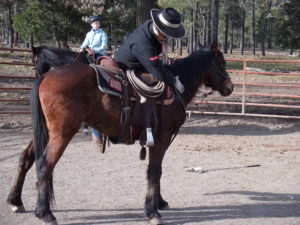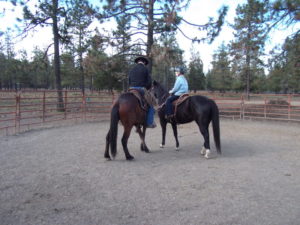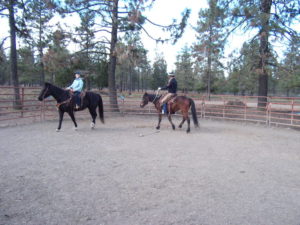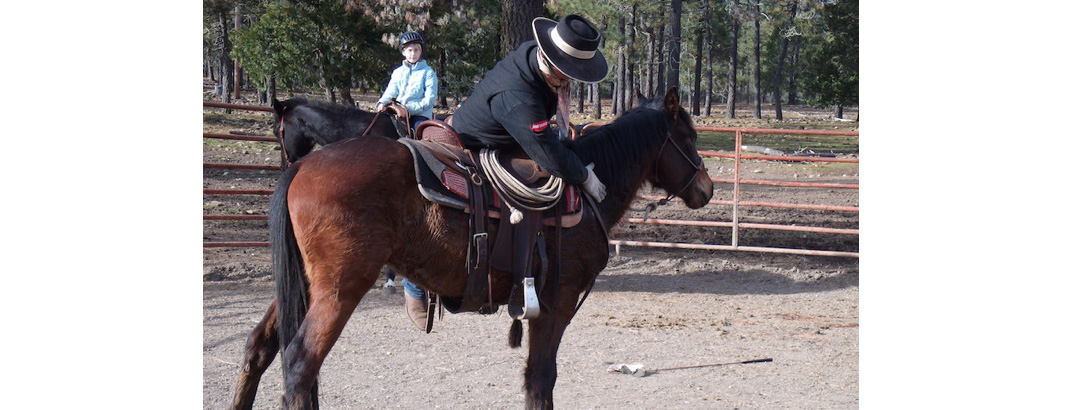Part 5: The First Ride
By Brent Rollins

The first ride is a very exciting and scary moment in training a mustang. This is what you have been waiting for and working towards. It is a day you will remember in the years to come when you and your mustang are headed down the trail together as trusted partners. If you’ve done your ground work faithfully up until now, the first ride should go fairly smoothly.
After you’re saddled and before you mount up, make sure to “work the saddle.” This means move the stirrups, pull on the back cinch, etc. Be sure there are no spots your mustang is apprehensive or spooky about. You won’t need a bridle or bit yet; the first ride should always be done in the halter. This keeps it simple for your horse because it is what he is already familiar and comfortable with. He has been directed with the halter ever since you taught him to lead and to bend.
When you first step up in the stirrup just lay your stomach and most of your weight across the saddle. While up there, pet your mustang all over, move your stirrups again and “check him out.” Do this until both you and the horse gain some confidence and courage. When you decide to swing all the way over don’t hesitate; swing on like you have been doing it the horse’s entire life. Once on the first rule is…get the heck off! Never get on for the first time and start trying to get your mustang to move forward. Make sure you can get off. Get on and off as many times as you want until he stands quiet. Since you’re riding in the halter, you will have to flip the rope over his head to change directions, so practice this a couple times on the ground to make sure it doesn’t bother him. If it does, keep it up until he gets over it.

Now that you have prepared your mustang to go forward, get on and get centered. Don’t just start kicking, as this may startle him and get you bucked off. Start by wiggling your legs on him. This is an in and out motion with your legs, not kicking. You can do this pretty firmly as you want to get him to move, just don’t shove your heels in him. If you normally wear spurs you may want to take them off. This will depend on the type of horse you have. Encourage your mustang to go forward with kisses, clucks and scooting in the saddle. All of your body should be saying “go forward.” When your horse finally starts to move don’t panic and pull on him, simply allow him to walk out and try to keep him walking. If he trots there is no guarantee that he won’t buck, but try to stay calm and let him move forward. In the first ride you are not trying to get any control, you are just getting him used to being ridden and to understand that it is okay. You can work on control later as he progresses.

Some mustangs will take more encouragement to go forward than others, it is fine to tap your horse on the rump to get him moving or have someone help by flagging. If he’s really stuck have someone lead him. If you have a friend with a good solid broke horse it is good to have your friend ride in front of you giving your mustang someone to follow. This buddy will help a spooky or unconfident horse feel more secure. Should your mustang become afraid or start bucking, the other rider might be able to ride in front of him and maybe slow him down or stop him. If nothing else, you have someone to ride with and talk to which will also make you feel more secure.
To stop your horse just bend him with the lead and say “whoa.” Bend him until his hind legs disengage and release when he stops. When he stops pet him and let him know he did well. At this point you can either step off or continue riding some more. You don’t have to stay on a long time. If you can just get him ridden—moving out a little and stopping—this is a good accomplishment for his first ride. Continue progressing a little more each day. You can introduce the bit at about ride 3 or 4 when he is getting used to the idea of ridden work. Have fun and try not to get bucked off. With consistency and dedication you will soon have a willing and capable partner for all the things you want to do.
Published May 2014 Issue
Brent Rollins is one of the industry’s leading experts on mustangs. He has been called the “mustang whisperer” by Craig Cameron. Brent is an EXCA cowboy race judge, and Craig Cameron certified Trainer. Brent travels Oregon, Washington and California giving clinics and expos, promoting the mustang and their versatility. He educates adopters and potential adopters on what to expect with their new mustang and deals with misconceptions regarding mustangs and domestic horses. He also helps with problem horses. Brent believes that every horse deserves a chance to be great. For more information about Brent and his program visit www.brhorsemanship.com.






